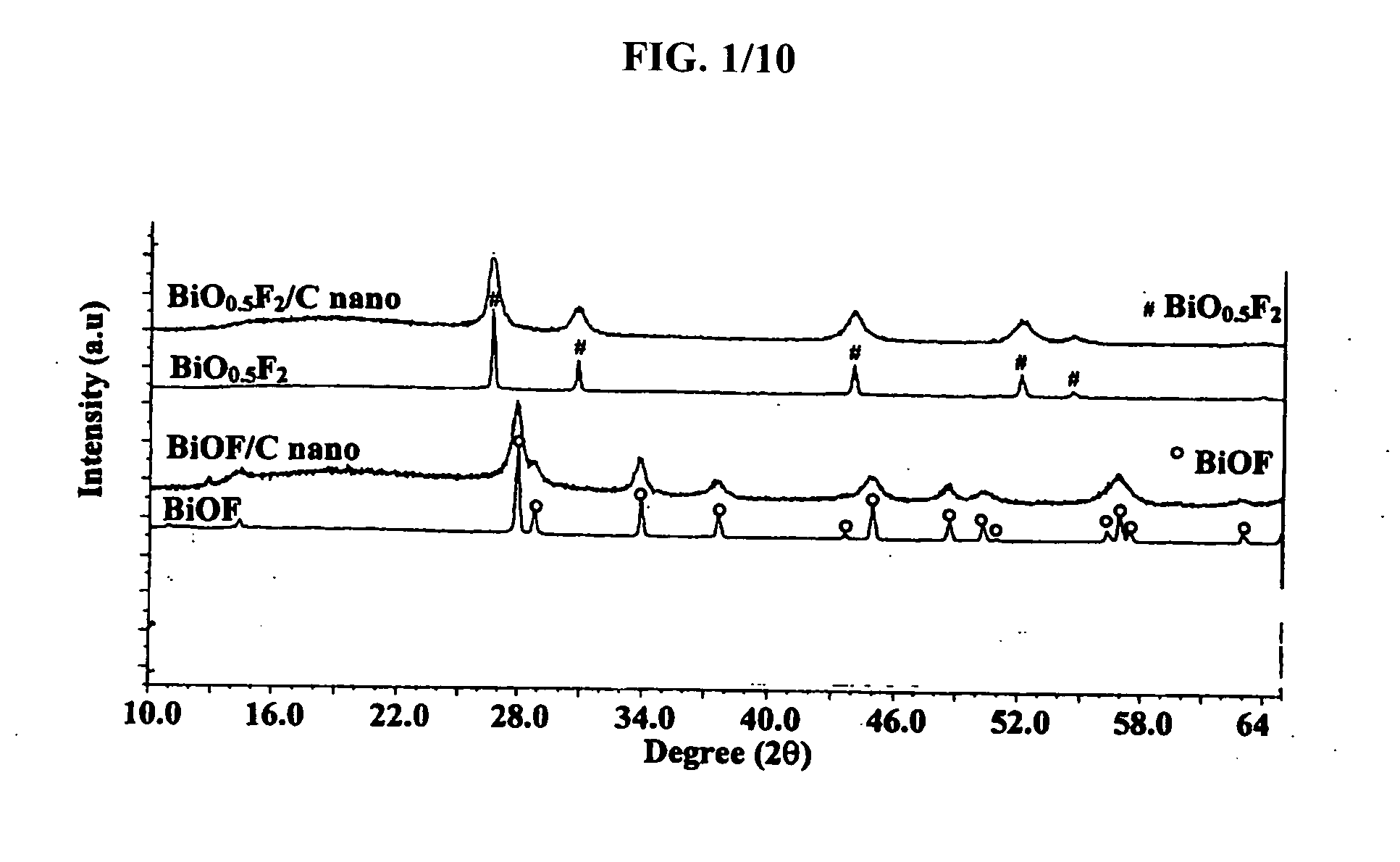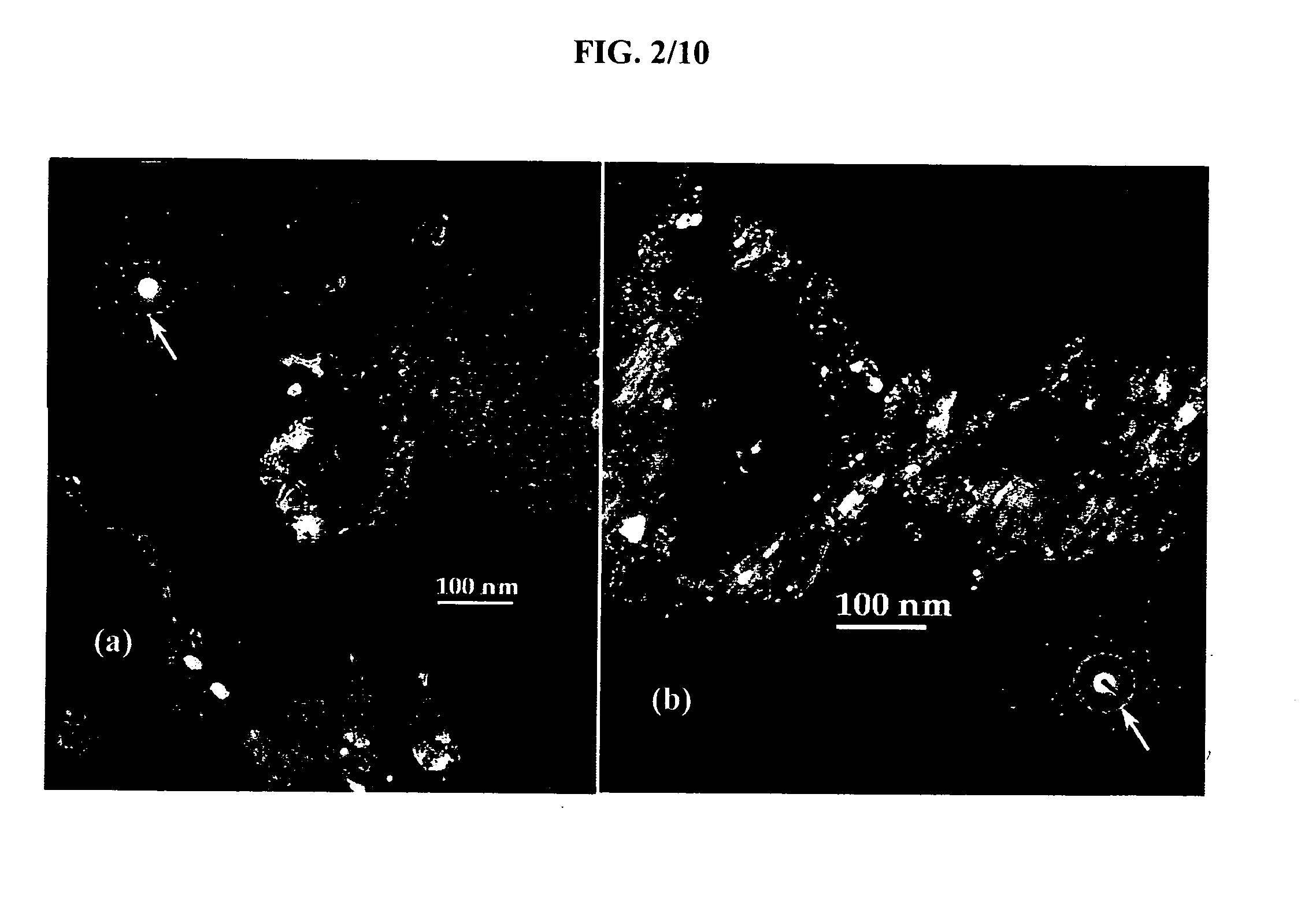Bismuth oxyfluoride based nanocomposites as electrode materials
a technology of oxyfluoride and nanocomposites, which is applied in the direction of arsenic compounds, cell components, halogen oxides/oxyacids, etc., can solve the problems of reducing the final acceptability of rechargeable cells, affecting the performance of rechargeable cells, and reducing the energy density of applications
- Summary
- Abstract
- Description
- Claims
- Application Information
AI Technical Summary
Benefits of technology
Problems solved by technology
Method used
Image
Examples
example 1
Preparation of the Nanocrystalline Bismuth Oxyfluoride Compounds of the Invention
[0066] Bi2O3 (Aldrich) was obtained commercially from available sources. BiOF and Bi0.5F2 were synthesized via the fluorination of Bi2O3 by a saturated aqueous NH4F solution according to the method provided in M. Bervas, B. Yakshinsky, L. C. Klein and G. G. Amatucci, “Soft-Chemistry Synthesis and Characterization of Bismuth Oxyfluorides and Ammonium Bismuth Fluorides”, J. American Ceramic Society, (2005), incorporated herein by reference. BiOxFz-2x / C (wherein 0xFz-2x / C wherein 0<x<1.5 and 3≦z≦5 with 15 wt % of either carbon black (Super P (MMM)) or activated carbon (Asupra (Norit)). The high-energy milling cell, as well as the balls, were hardened steel. The high-energy milling cell was sealed and reopened inside a He filled glovebox at −80° C. dew point, thus isolating the powder from moisture or oxygen contamination.
[0067] The BiOxFz-2x / C macrocomposites, (wherein 0xFz-2x / C (wherein 0
example 2
Electrode Preparation
[0068] Electrodes were fabricated by utilizing acetone based slurry containing the active material, a poly(vinylidene fluoride-co-hexafluoropropylene) (Kynar 2801, Elf Atochem)) binder, carbon black (super P, MMM) and dibutyl phtalate (Aldrich) plasticizer in the ratio 39 / 21 / 8 / 32. The slurry was then tape casted. Once dried, the freestanding tape was placed in 99.8% anhydrous ether (Aldrich) to extract the dibutyl phtalate (DBP). After DBP extraction, the active material loading of the tape was 57+ / −%. Discs of about 1 cm2 punched from these tapes were tested in coin cells against lithium metal (Johnson Matthey). The data presented herein were obtained at a controlled temperature. The battery cycler was either an Arbin or a Mac Pil (Biologic) and all cells were cycled under constant current. The electrolyte was composed of LiClO4 in EC / DMC at 0.4 M (1:1 ratio by volume).
example 3
Physical Characterization of Bismuthoxyfluoride Nanocomposites
[0069] In order to characterize the structure of the inventive bismuth oxyfluoride nanocomposites, XRD analyses were performed on a Sintag X2 using Cu Kα radiation. Inventive nanocomposites to be analyzed ex-situ were placed on glass slides and covered with a Kapton film sealed with silicon based vacuum grease inside a glove box to minimize air exposure. For in-situ XRD analysis, the electrode was placed in an in-situ cell. An isolated beryllium window was placed on top of the working electrode to isolate it from the atmosphere while allowing the x-rays to penetrate with minimal loss due to x-ray absorption.
[0070] In order to assess the nanocrystalline nature of the material, TEM analysis was performed. Bright Field (BF), Dark Field (DF) and Selected Area Electron Diffraction (SAED) images were taken with a Topcon 002B Transmission Electron Microscope (TEM). For that purpose, the powder samples first were dispersed in a...
PUM
 Login to View More
Login to View More Abstract
Description
Claims
Application Information
 Login to View More
Login to View More - R&D
- Intellectual Property
- Life Sciences
- Materials
- Tech Scout
- Unparalleled Data Quality
- Higher Quality Content
- 60% Fewer Hallucinations
Browse by: Latest US Patents, China's latest patents, Technical Efficacy Thesaurus, Application Domain, Technology Topic, Popular Technical Reports.
© 2025 PatSnap. All rights reserved.Legal|Privacy policy|Modern Slavery Act Transparency Statement|Sitemap|About US| Contact US: help@patsnap.com



